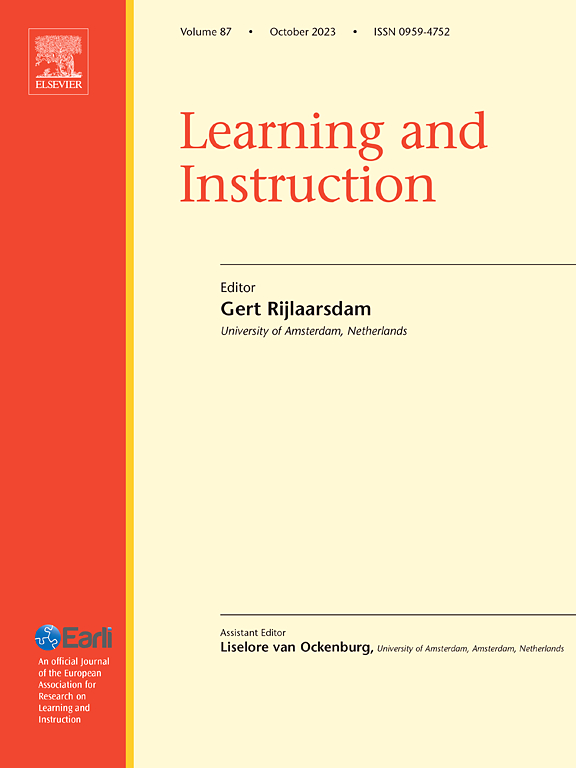Reading literacy decline in Europe: Disentangling school closures and out-of-school learning conditions during the COVID-19 pandemic
IF 4.9
1区 教育学
Q1 EDUCATION & EDUCATIONAL RESEARCH
引用次数: 0
Abstract
Background
This study examines the decline in average reading literacy among elementary school students in European countries between 2016 and 2021, as documented by the Progress in International Reading Literacy Study (PIRLS). This period was characterized by disruptions caused by COVID-19-related school closures and changes in student composition, influenced by societal trends found in many European countries.
Aims
We estimated trends in reading literacy adjusted for changes in student composition to assess the relationship between the duration of school closures and school-related learning loss.
Sample
We utilized data from 2016 to 2021 with a sample of N = 187,386 students from 18 European countries/regions participating in the PIRLS; this involved a representative sample of approximately 5000 fourth-graders per year and country/region (Age M = 10.28, SD = 0.86; 49.50 % female).
Methods
Our analytical approach employed propensity score weighting to balance changes in student composition between the 2016 and 2021 student cohorts.
Results
Our findings revealed changes in out-of-school learning conditions across most of the 18 countries/regions. The average adjusted decline in reading literacy across all 18 European countries/regions was significantly lower than the observed decline, but it remained substantial. The expected decline was associated with the duration of COVID-related school closures, estimated at −0.0015 SDs per day.
Conclusions
This study sheds new light on how student composition and school-related factors influence trends in reading literacy. School closures and changes in the composition of student cohorts played a substantial role in the decline in reading literacy observed between 2016 and 2021.
欧洲阅读识字率下降:解开COVID-19大流行期间学校关闭和校外学习条件的关系
本研究考察了2016年至2021年期间欧洲国家小学生平均阅读能力下降的情况,这是国际阅读能力研究进展(PIRLS)所记录的。这一时期的特点是,受许多欧洲国家社会趋势的影响,与covid -19相关的学校关闭和学生组成的变化造成了中断。目的:我们根据学生构成的变化对阅读能力的趋势进行了估计,以评估学校关闭时间与学校相关学习损失之间的关系。样本:我们使用了2016年至2021年的数据,样本N = 187386名来自18个欧洲国家/地区参与PIRLS的学生;该研究涉及每年约5000名四年级学生和国家/地区的代表性样本(年龄M = 10.28, SD = 0.86;49.50%为女性)。方法采用倾向得分加权分析方法来平衡2016年和2021年学生群体中学生组成的变化。结果我们的研究结果揭示了18个国家/地区中大多数国家/地区校外学习状况的变化。所有18个欧洲国家/地区的阅读能力平均调整后的下降幅度明显低于观察到的下降幅度,但仍然很大。预期的下降与covid - 19相关学校关闭的持续时间有关,估计为每天- 0.0015个SDs。本研究揭示了学生作文和学校相关因素如何影响阅读能力的趋势。在2016年至2021年期间观察到的阅读能力下降中,学校关闭和学生群体组成的变化发挥了重要作用。
本文章由计算机程序翻译,如有差异,请以英文原文为准。
求助全文
约1分钟内获得全文
求助全文
来源期刊

Learning and Instruction
Multiple-
CiteScore
11.30
自引率
4.80%
发文量
109
期刊介绍:
As an international, multi-disciplinary, peer-refereed journal, Learning and Instruction provides a platform for the publication of the most advanced scientific research in the areas of learning, development, instruction and teaching. The journal welcomes original empirical investigations. The papers may represent a variety of theoretical perspectives and different methodological approaches. They may refer to any age level, from infants to adults and to a diversity of learning and instructional settings, from laboratory experiments to field studies. The major criteria in the review and the selection process concern the significance of the contribution to the area of learning and instruction, and the rigor of the study.
 求助内容:
求助内容: 应助结果提醒方式:
应助结果提醒方式:


